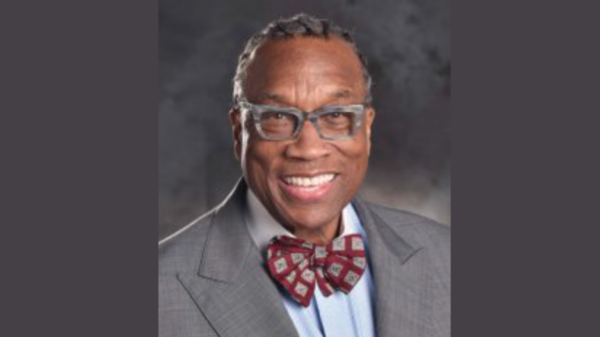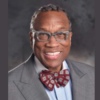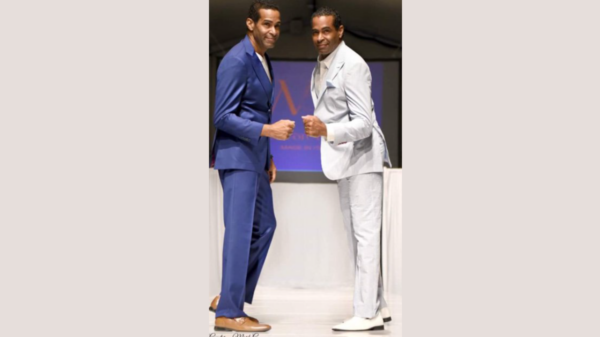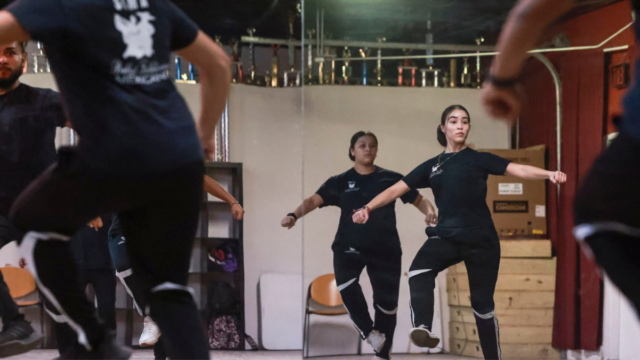
Inside a dance studio with floor-to-ceiling mirror walls, the plywood floor creaks every time dancers from the Ballet Folklórico SIMA stamp their leather-sole shoes while practicing the choreography of the Danzón Flor de Azar, a folk song.
The dancing pairs — ages 15 to 25 — move their bodies elegantly, following the slow tempo rhythm’s swings and turns. Their faces barely crack a smile while they focus on mastering every movement and following the music’s beat.
“Vamos, parapa, pam, pam, pam, a la izquierda y ahora a la derecha. Let’s go, guys,” says instructor Christopher Fierro, asking them to move first to the left and then to the right and mixing English and Spanish as he led practice at an Irving dance studio one recent Saturday. Fierro, 22, is both a dancer and instructor.
These dancers embrace folklórico dancing not just as a hobby or an activity to make new friends, but because they see dancing as a way to connect with the Hispanic culture and their family history. As the Latino segment of the population becomes the largest majority in Texas, folklórico ensembles are one of the symbols of the cultural influence of Mexican traditions in the state. In Dallas County, at least 36% of the population is Mexican or Mexican-American, according to the U.S. Census.
Many of the dancers are second or third-generation Hispanics who fell in love with folklórico. For some, the dance academy is also a place where they can learn or practice Spanish.
Fierro mixes both languages while explaining dance moves for each song.
“Sí se puede” and “vamos,” he encourages his pupils. “Yes, you can,” and “let’s go.”
Learning dance moves can be hard, so Fierro tries to ensure that language proficiency or preference is not an obstacle.
“If I have to talk to them in ‘Spanglish’ so they feel comfortable and understand me, that’s fine. I have to put myself in their shoes. We want them to feel at ease here, so they can enjoy dancing and learning their traditions”, said Fierro, a business student at the University of Texas at Austin.
Fierro, who was born in Dallas, has been dancing since he was 3. His parents are from Durango. He credits all the years of folklórico dancing for building up a connection to his family’s Mexican roots.
He conveys those teachings to his students at SIMA.
Alberto Medrano, 18, a dancer for this company, said folklórico dancing brought a deeper understanding of his family heritage.
“I see dance as a way to connect with my family and learn more about where my parents come from and all the beautiful things Mexico has,” said Medrano, whose parents are from Guerrero, Mexico.
He was born in Irving and is attending El Centro Community College in downtown Dallas.
Medrano became interested in folklórico when he was 15, after he participated as a chambelán, a dance partner at a Quinceañera.

‘Let’s get serious’
During Saturday practice at SIMA, girls wear their hair tied up in a bun with braid decorations.
Male and female dancers wear black t-shirts with the dance company’s logo and sweatpants. All wear shoes with Cuban heels with nails on the soles.
In between songs, the young dancers joke around in the dance studio, which has become their second home — they spend more than eight hours a week there.
But when Fierro demands their attention, their chit-chat and joking around stops.
Practice sessions are not just meant to rehearse their performances, but that’s when these dancers soak in the connection to their families’ heritage and solidify their identity.
“It’s about fellowship, that’s what I enjoy the most. Feeling at home, and knowing that my friends are here,” said Marilyn López, 19, a 2021 MacArthur High School graduate.
López, whose parents came from Michoacán and Morelos, has been practicing folklórico for six years.
“The passion and love for dancing unite us,” said López, who is also an instructor.
SIMA director Silvia Parra said many parents bring their children to the academy seeking to help them understand their identity and roots.
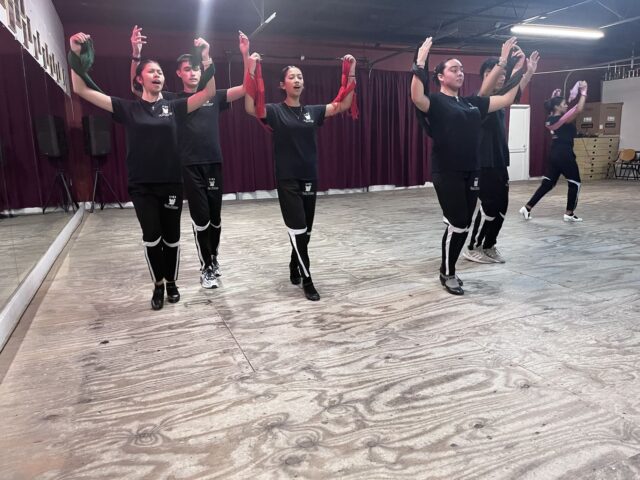
Benjamín Dominzain, 19, whose father is from Guanajuato, Mexico and lives in Bedford, can attest to that.
“My mom wanted me to dance so that I wouldn’t lose my father’s traditions and language,” said Dominzain, who attends Texas Wesleyan University.
“I started dancing at 5, so it’s something I love. I haven’t stopped since, and I don’t want to quit dancing. It’s something beautiful.”
Discipline and skills for life
At Garland’s Mexico 2000 Dance School, young dancers arrive to practice wearing smiles and full of energy, but they can’t go into the studio right away.
“Can I come in?” they ask as they arrive, wearing their black T-shirt with a Mexico 2000 logo in red and wearing Cuban heel shoes.
Respect, discipline, and order come first.
“It’s about teaching them a little of everything, not just dance — self-respect, respecting their time, my time, [and] their teammates,” said Alex Palencia, Mexico 2000 director and coach for 20 years. “Discipline is essential to succeed in dancing [folklórico], and in their lives.”
Palencia, from Mexico City, said dancing helps children and teens develop many social skills, allows them to express themselves with their bodies, and develops a sharp mind.
During performances, the dancers must not only coordinate multiple parts of their bodies and obey the music’s rhythm and tempo, but also sync their movements with their dance partner’s. It’s about leading and being led on the dance floor.
“It’s good to teach them from an early age, through dance, what teamwork means: Everyone shares a responsibility in the success of the dance act,” Palencia said.
Marisol Desiderio said her daughter Jessica, 17, thrived in her schoolwork once she started dancing folklórico.
Jessica attends John D. Horn High in Mesquite and started dancing about three years ago as an after-school activity.
She treasures learning about traditions from his father’s homeland, León, Mexico.
Her mother said she’s now an A-straight student and plans to attend the University of Texas Rio Grande Valley because it has a folklórico dance program.
The arts are a window to history.
At this academy, teens also learn the origin behind every music piece they dance to.
“They are the ones who will preserve our culture [and] pass it on to future generations, so they need them to know what each thing means,” said Mexico 2000 director Mary Palencia.







